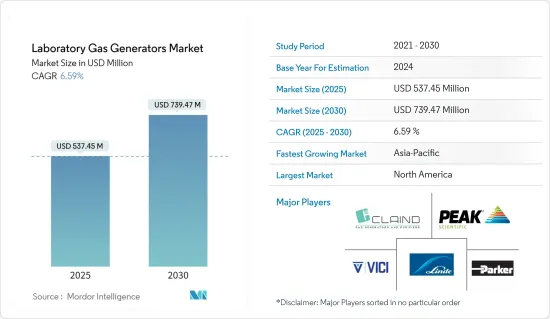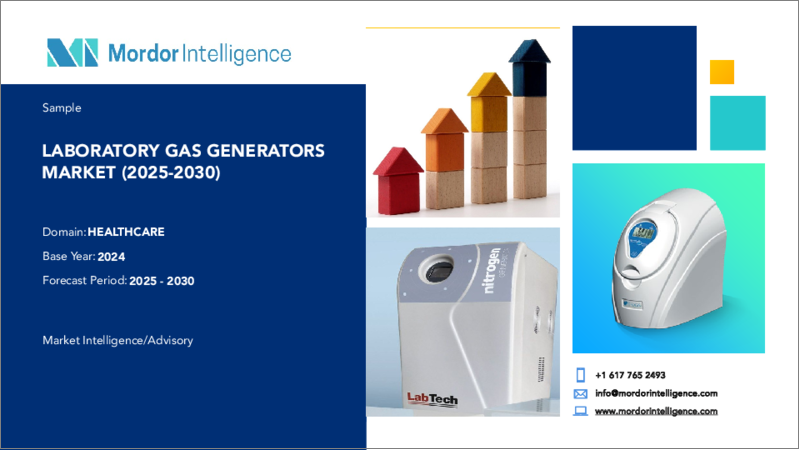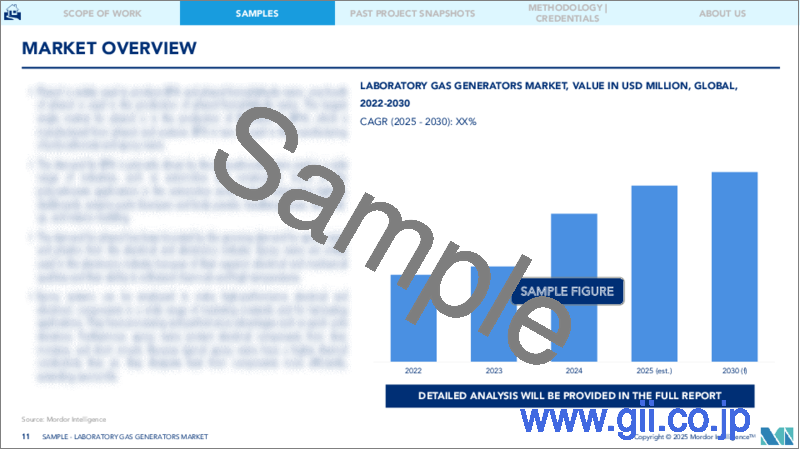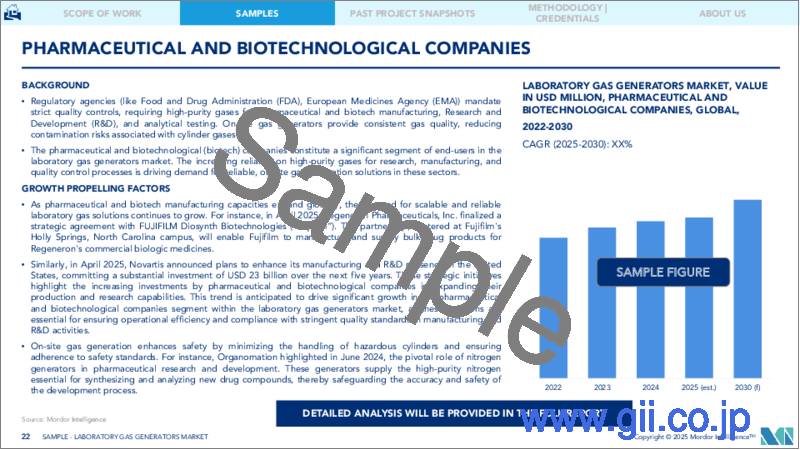|
|
市場調査レポート
商品コード
1689710
ラボ用ガス発生器:市場シェア分析、産業動向・統計、成長予測(2025~2030年)Laboratory Gas Generators - Market Share Analysis, Industry Trends & Statistics, Growth Forecasts (2025 - 2030) |
||||||
カスタマイズ可能
適宜更新あり
|
|||||||
| ラボ用ガス発生器:市場シェア分析、産業動向・統計、成長予測(2025~2030年) |
|
出版日: 2025年03月18日
発行: Mordor Intelligence
ページ情報: 英文 111 Pages
納期: 2~3営業日
|
全表示
- 概要
- 目次
ラボ用ガス発生器市場規模は2025年に5億3,745万米ドルと推定され、予測期間(2025~2030年)のCAGRは6.59%で、2030年には7億3,947万米ドルに達すると予測されています。

COVID-19は、操業とサプライチェーンの中断、顧客需要の減少、世界の景気減速により、実験室用ガス発生器市場に影響を与えました。したがって、世界中の学術機関やラボの閉鎖は、企業のセグメント収益の大幅な損失をもたらしました。さらに、実験用ガス発生器の需要は、COVID-19関連の実験室ベースの研究開発活動により、パンデミック中に増加しました。例えば、2021年6月、Novagenixは、トルコにおける医薬品の有効性と品質を評価・認証するためのCOVID-19創薬研究でPEAK窒素発生器を使用しました。このようなCOVIDの創薬における実験用ガス発生器の使用は、パンデミックの間、実験用ガス発生器の需要を牽引しました。このように、COVID-19のパンデミックは市場の成長を押し上げ、本調査の予測期間中も同様の牽引力が続くと予想されます。
この市場の成長は主に、従来のガスシリンダーの使用に関連する安全性への懸念の高まり、医薬品や食品の承認プロセスにおける分析技術の重要性の高まり、対象産業における研究開発費の増加によってもたらされます。
分析化学は医薬品開発において重要な役割を果たしており、新薬の品質、安全性、有効性を保証しています。製薬セグメントではいくつかの分析手法が利用されているが、主に3つの一般的な分析手法が、構造決定、分析対象物の分離、対象化合物の定量に使用されています。これらには、クロマトグラフィー、分光学、従来の分析化学技術が含まれます。不純物や薬学的に活性な化合物を含む危険な化学品の検出と同定に、分析検査の応用が拡大しています。この文脈において、2022年3月に発表されたAzo opticsの記事では、紫外線/可視光(UV/Vis)と赤外(IR)分光法は、完成した食品中の食品添加物の存在を定量化するために使用される2つの標準的な分光技術であると述べられています。これら2つの方法は、食品添加物の化学組成、食感特性、品質に関連する側面に関する重要な詳細を提供することができます。このように、食品承認プロセスの分析検査における分光法の使用増加に伴い、ラボ用ガス発生器も増加し、それによって市場の成長が促進されると予想されます。
さらに、高速液体クロマトグラフィー(HPLC)技術は、薬剤分子が拡散する生体環境をシミュレートするために、タンパク質やリン脂質を含む据置型を使用し、バイオミメティッククロマトグラフィーとして知られています。2022年4月にEuropean Chemical Societiesが発表した紙製では、薬剤や農薬の水生毒性を予測するためにバイオミメティッククロマトグラフィーのデータを使用することが述べられています。このような分析技術の採用が増加することで、分析に頻繁に使用されるラボ用ガス発生器の需要が高まり、市場成長の原動力になると予想されます。
さらに、2022年7月に発表されたPharmaVoiceの記事によると、2022年までの5年間で、バイオテクノロジー部門の研究開発費は約倍増しました。バイオテクノロジーラボは管理された環境であるため、窒素ラボ用ガス発生器は主にこのようなラボで使用されます。このように、バイオテクノロジー産業への投資の増加に伴い、ラボ用ガス発生器の成長が見込まれています。
さらに、市場参入企業は買収、合併、製品発売などの戦略にも関与しています。例えば、2022年8月、Tisch EnvironmentalはAADCO Instruments(Advanced Analytical Device Company)を買収しました。AADCOは、ゼロエア発生器の最先端ラインを開発しています。
したがって、医薬品や食品の承認プロセスにおける分析技術の重要性の高まり、研究開発費の増加、M&Aなどの市場参入企業の活動の活発化などの要因が、予測期間中に成長を示すと予想されます。しかし、従来のガス供給方法からの置き換えに対する消極的な姿勢や熟練者の不足が、市場の成長を抑制すると予想されます。
ラボ用ガス発生器市場の動向
予測期間中、窒素ガス発生器が市場で大きなシェアを占める見込み
窒素ガス発生器は、予測期間中、調査対象セグメントの成長に貢献すると期待されています。窒素ガス発生器は、圧縮空気から窒素分子を分離する機械です。食品産業、半導体、石油、化学、研究機関などで広く採用されています。医薬品や食品の承認プロセスにおける分析技術の重要性の高まり、食品の安全性に対する懸念の高まり、対象産業における研究開発費の増加といった要因が、このセグメントの成長を促進しています。さらに、他の化合物との反応性が低く、周囲の酸素レベルを制御できるなどの利点により、液体クロマトグラフィー質量分析(LC-MS)分析の実施、蒸発光散乱検出器(ELSD)の操作、体外受精(IVF)インキュベーターの環境条件維持において、窒素ガス発生器の採用が増加しています。
従来の窒素ボンベには、漏れのリスクが高いなど、いくつかの欠点があります。例えば、2021年1月に発表されたNPRの調査記事では、ジョージア州北東部の養鶏場で、いかに危険な窒素漏れが6人を死亡させ、11人の入院を引き起こしたかを実証しています。同報告書はまた、加圧された可燃性の高い大量の窒素をラボに保管することで、火災や爆発のリスクが高まることにも言及しています。そのため、こうしたリスクを軽減する先進的窒素ガス発生器の需要が高まっています。これらの窒素ガス発生器は、コンパクトで一貫性があり、コスト効率が高く、操作が簡単です。したがって、このような進歩が窒素ガス発生器の需要を押し上げています。
さらに、企業は買収、合併、製品発売などのマーケティング戦略にも関与しています。例えば、2021年9月には、Nikkiso CosmodyneがTGNO-1,000ガス状酸素・窒素プラントを最近稼働させたと、Nikkiso Cryogenic Industriesのクリーンエネルギー産業ガスグループが報告しています。TGNOは極低温酸素・窒素発生器で、中・高圧の窒素ガスと酸素ガスの3種類の気体製品を製造するよう設計されています。
さらに、2021年7月、Scientific Laboratory Supplieは、SLSラボプロガスと液体窒素発生器の製品ラインを立ち上げ、英国とアイルランドで独占販売しました。この技術により、ラボはガス供給をコントロールすることができ、ガスボンベの国を越えた輸送の必要性をなくすことで持続可能性を促進することができます。
同様に、様々な生物製剤や医薬品開発のための研究開発の高まりも、窒素ガス発生器の需要拡大にプラスに働くと予想されます。
このように、従来の窒素ボンベよりも窒素ガス性能に対する嗜好の高まりと革新的な製品の発売により、窒素ガス発生器市場全体は本調査の予測期間中に安定した成長を遂げると考えられます。
北米は予測期間中にラボ用ガス発生器市場で大きなシェアを占める見込み
北米は、同地域の多数の製薬とその他の産業における研究開発活動の増加により、大きな市場シェアを占めると予想されます。北米地域のラボ用ガス発生器市場の成長を促進する主要因には、確立されたインフラと製薬産業の研究開発費の増加が含まれます。
米国では最近、さまざまな製薬会社や政府組織による研究開発(R&D)への支出が増加しており、予測期間中の市場成長を促進すると予測されています。例えば、世界の製薬会社の1つであるNovartis AGの2021年の年次報告書によると、研究開発のために2021年に148億8,600万米ドルを投資しており、2020年の141億9,700万米ドルから増加しています。また、もう一つの大手製薬メーカーであるPfizerの2021年の年次報告書に記載されているように、2021年の研究開発投資額は138億2,900万米ドルであり、2020年の93億9,300万米ドルから大幅に増加しました。このように、製薬産業における研究開発費の増加は、実験用ガス発生器の需要にプラスに反映されると予想されます。ガス発生器は医薬品製造やダウンストリームプロセスにおいて重要な役割を果たすため、この地域における市場の成長に寄与しています。
さらに、2021年6月、SanofiはmRNA Center of Excellenceを立ち上げ、米国における次世代ワクチンの開発と提供を加速するために4億1,014万米ドル以上を投資しました。先進的ワクチンを製造するための製造施設の設立は、製薬・バイオ医薬品産業セグメントにおいて実験用ガス発生器を使用する機会を創出する可能性が高いです。そのため、同地域の市場成長の原動力になると予想されます。
研究機関や大学は新技術の開発に取り組んでおり、予測期間中に同国の市場開拓に貢献すると期待されています。例えば、2022年2月、マサチューセッツ工科大学(MIT)リンカーンラボは、アルミニウムを水素燃料に変換するプロトタイプ装置であるポータブル水素燃料発生器のデモンストレーションを行りました。この装置はHydrogen Tactical Refueling Point(H-TaRP)と呼ばれています。アルミニウムディスペンサー、反応容器、水冷システム、水素タンクに充填するための制御システムマニホールドで構成されています。
したがって、研究開発費の増加、先進的な新技術の迅速な採用、この地域の重要な市場参入企業などの要因が、予測期間中の北米の市場成長に貢献すると予想されます。
ラボ用ガス発生器産業概要
市場競争は緩やかで、数カ国の地場企業といくつかの国際的参入企業で構成されています。ラボ用ガス発生器市場の主要企業には、Claind S.r.l.、ErreDue spa、F-Dgsi、Labtech S.R.L.、LNI Swissgas、Nel ASA、Parker-Hannifin Corporation、Peak Scientific Instruments, Ltd、VICI DBS S.r.l.などがあり、世界中でこれらの製品を提供しています。
その他の特典
- エクセル形式の市場予測(ME)シート
- 3ヶ月間のアナリストサポート
目次
第1章 イントロダクション
- 調査の前提条件と市場定義
- 調査範囲
第2章 調査手法
第3章 エグゼクティブサマリー
第4章 市場力学
- 市場概要
- 市場促進要因
- 従来のガスシリンダーの使用に関する安全性への懸念の高まり
- 医薬品・食品の承認プロセスにおける分析技術の重要性の高まり
- 対象産業における研究開発費の増加
- 市場抑制要因
- 従来のガス供給方法からの置き換えへの難色
- 熟練した人材の不足
- ポーターのファイブフォース分析
- 供給企業の交渉力
- 買い手/消費者の交渉力
- 新規参入業者の脅威
- 代替品の脅威
- 競争企業間の敵対関係の強さ
第5章 市場セグメンテーション
- タイプ別
- 窒素ガス発生器
- 水素ガス発生器
- ゼロエア発生器
- TOCガス発生器
- その他のガス発生器
- エンドユーザー別
- 飲食品会社
- 化学・石油化学企業
- 製薬・バイオテクノロジー企業
- 地域別
- 北米
- 米国
- カナダ
- メキシコ
- 欧州
- ドイツ
- 英国
- フランス
- イタリア
- スペイン
- その他の欧州
- アジア太平洋
- 中国
- 日本
- インド
- オーストラリア
- 韓国
- その他のアジア太平洋
- 中東・アフリカ
- GCC諸国
- 南アフリカ
- その他の中東・アフリカ
- 南米
- ブラジル
- アルゼンチン
- その他の南米
- 北米
第6章 競合情勢
- 企業プロファイル
- Claind S.r.l.
- ErreDue spa
- F-Dgsi
- Labtech S.R.L.
- LNI Swissgas
- Nel ASA
- Parker-Hannifin Corporation
- Peak Scientific Instruments, Ltd.
- Linde Plc(Praxair Technology Inc.)
- Valco InstrumenValco Instruments Company, Inc(VICI DBS SRL)
- On Site Gas Systems Inc
- Isolcell S.p.A
- Oxymat A/S
第7章 市場機会と今後の動向
The Laboratory Gas Generators Market size is estimated at USD 537.45 million in 2025, and is expected to reach USD 739.47 million by 2030, at a CAGR of 6.59% during the forecast period (2025-2030).

COVID-19 impacted the laboratory gas generators market due to the disruption of operation and supply chain, decreased customer demand, and global economic slowdown. Thus, the closure of academic institutions and laboratories across the globe has resulted in a significant loss of segmental revenue for businesses. Moreover, the demand for laboratory gas generators increased during the pandemic due to COVID-19-related laboratory-based research and development activity. For instance, in June 2021, Novagenix used PEAK nitrogen generators in their COVID-19 drug discovery study to assess and certify the efficacy and quality of medications in Turkey. Such usage of laboratory gas generators in drug discovery of COVID drove the demand for laboratory gas generators during the pandemic. Thus, the COVID-19 pandemic has boosted the market's growth and is expected to follow the same traction during the forecast period of the study.
The growth in this market is primarily driven by the rising safety concerns related to conventional gas cylinders use, the growing importance of analytical techniques in drug and food approval processes, and increasing R&D spending in target industries.
Analytical chemistry plays a crucial role in drug development, ensuring novel medications' quality, safety, and efficacy. Although several analytical methods are utilized in the pharmaceutical sector, three general analytical techniques are chiefly used to determine the structure, separate analytes, and quantify target compounds. These include chromatography, spectroscopy, and conventional analytical chemistry techniques. The application of analytical testing is growing for detecting and identifying dangerous chemicals, including both adulterants and pharmaceutically active compounds. In this context, the Azo optics article published in March 2022 stated that ultraviolet/visible (UV/Vis) and infrared (IR) spectroscopy are two standard spectroscopic techniques used to quantify the presence of food additives in their finished food items. These two methods can offer crucial details about the chemical composition, textural traits, and quality-related aspects of food additives. Thus, with the increasing spectroscopy use for analytical testing of the food approval process, laboratory gas generators are also expected to increase, thereby boosting the market growth.
Furthermore, high-performance liquid chromatography (HPLC) techniques use stationary phases containing proteins and phospholipids to simulate the biological environment where diffused drug molecules are known as biomimetic chromatography. The article published by European Chemical Societies in April 2022 mentioned using biomimetic chromatographic data to forecast the aquatic toxicity of drugs and pesticides. Such increasing adoption of these analytical techniques is expected to generate the demand for laboratory gas generators, frequently used to perform them, thereby driving the market growth.
Additionally, the PharmaVoice article published in July 2022 stated that in the five years running up to 2022, the biotechnology sector's R&D spending nearly doubled. As the biotechnology labs are a controlled environment, the nitrogen laboratory gas generators are primarily used in such labs. Thus, with the increasing investment in the biotechnology industries, the growth of laboratory gas generators is anticipated.
Moreover, market players are also involved in strategies such as acquisitions, mergers, and product launches, among others. For instance, in August 2022, Tisch Environmental acquired AADCO Instruments (Advanced Analytical Device Company). The company AADCO is developing a state-of-the-art line of Zero Air Generators.
Hence, factors such as the growing importance of analytical techniques in drug and food approval processes, growing R&D expenditure, and increased market player activities such as mergers and acquisitions are expected to witness growth over the forecast period. However, reluctance to replace conventional gas supply methods and lack of skilled personnel is expected to restrain the market's growth.
Laboratory Gas Generators Market Trends
Nitrogen Gas Generators is Expected to Hold Significant Share in the Market Over the Forecast Period
Nitrogen gas generator is expected to contribute to the growth of the studied segment over the forecast period. Nitrogen gas generators are machines that separate nitrogen molecules from compressed air. It is widely adopted in the food industry, semiconductors, petroleum, chemistry, and research institutes. Factors such as the growing importance of analytical techniques in drug and food approval processes, rising food safety concerns, and increasing R&D spending in target industries are driving segment growth. Additionally, advantages such as low reactivity with other compounds and the ability to control ambient oxygen levels are increasing the adoption of nitrogen gas generators in carrying out liquid chromatography-mass spectrometry (LC-MS) analysis to operating evaporative light scattering detectors (ELSDs) and maintaining environmental conditions in Vitro Fertilization (IVF) incubators.
Conventional nitrogen cylinders are associated with several downsides, such as a higher risk of leaks. For instance, an NPR study article published in January 2021 demonstrated how dangerous nitrogen leaks had killed six people and caused 11 hospitalizations in the Northeast Georgia poultry plant. The report also mentions that storing vast amounts of pressurized, highly flammable nitrogen in laboratories increases the risk of fire and explosions. Hence there is an increase in demand for advanced nitrogen gas generators as it mitigates these risks. These nitrogen gas generators are compact, consistent, cost-effective, and easy to operate. Thus, such advancements boost the demand for nitrogen gas generators.
Moreover, companies are also involved in marketing strategies such as acquisitions, mergers, and product launches. For instance, in September 2021, another company Nikkiso Cryogenic Industries' Clean Energy & Industrial Gases Group, reported that Nikkiso Cosmodyne recently commissioned its TGNO-1000 gaseous oxygen and nitrogen plant. TGNO is a cryogenic oxygen and nitrogen generator designed to produce three gaseous product streams, which are medium and high-pressure nitrogen and oxygen gas.
Additionally, in July 2021, Scientific Laboratory Supplies launched a line of SLS lab pro gas and liquid nitrogen generators, available exclusively in the UK and Ireland. This technology gives laboratories control over their gas supplies and promotes sustainability by eliminating the need for cross-country transportation of gas canisters.
Likewise, the rising research and expenditure for developing various biologics or pharmaceutical products are also expected to reflect positively on the growing demand for nitrogen gas generators.
Thus, due to the growing preference for nitrogen gas performance over conventional nitrogen cylinders and innovative product launches, the overall market for nitrogen gas generators will grow steadily over the forecast period of the study.
North America is Expected to Hold Significant Share in the Laboratory Gas Generators Market Over the Forecast Period
North America is expected to hold a significant market share, owing to the rise in research and development activities among numerous pharmaceutical and other industries in the region. The major factors driving the growth of the laboratory gas generators market in the North American region include the well-established infrastructure and increased R&D spending for the pharmaceutical industry.
The high expenditure on research and development (R&D) by various pharmaceutical companies and government organizations has been increasing recently in the US, anticipated to drive market growth over the forecast period. For instance, per the 2021 annual reports of Novartis AG, one of the global pharmaceutical companies, invested USD 14,886 million in 2021 for R&D, which increased from USD 14,197 million in 2020. In addition, another major pharmaceutical manufacturer, Pfizer Inc., invested USD 13,829 million in 2021 on R&D, which increased heavily compared to USD 9,393 in 2020, as mentioned in the 2021 annual report of the company. Thus, the increased research and development expenses in the pharmaceutical industry are expected to reflect positively on the demand for laboratory gas generators. They play a crucial role in drug production and down-streaming processes, thereby contributing to the market's growth in this region.
Additionally, in June 2021, Sanofi launched the mRNA Center of Excellence and invested over USD 410.14 million to accelerate developing and delivering next-generation vaccines in the US. Establishing manufacturing facilities to produce advanced vaccines will likely create opportunities for using laboratory gas generators in the pharmaceutical and biopharmaceutical industry segment. Thus, it is expected to drive market growth in the region.
Research organizations and universities are taking initiatives to develop new technologies, which are expected to contribute to the market growth in the country during the forecast period. For instance, in February 2022, the Massachusetts Institute of Technology (MIT) Lincoln Laboratory demonstrated a portable hydrogen fuel generator, a prototype device to convert aluminum into hydrogen fuel. The device is called the Hydrogen Tactical Refueling Point (H-TaRP). It comprises an aluminum dispenser, reactor vessel, water cooling system, and a control system manifold to fill a hydrogen tank.
Therefore, the factors such as rising research and development expenditure, quick adoption of advanced new technologies, and significant market players in this region are expected to contribute to the market's growth in North America during the forecast period.
Laboratory Gas Generators Industry Overview
The market studied is moderately competitive and consists of local players across several countries and some international players. The major players in the laboratory gas generators market include Claind S.r.l., ErreDue spa, F-Dgsi, Labtech S.R.L., LNI Swissgas, Nel ASA, Parker-Hannifin Corporation, Peak Scientific Instruments, Ltd and VICI DBS S.r.l., providing these products across the globe.
Additional Benefits:
- The market estimate (ME) sheet in Excel format
- 3 months of analyst support
TABLE OF CONTENTS
1 INTRODUCTION
- 1.1 Study Assumptions and Market Definition
- 1.2 Scope of the Study
2 RESEARCH METHODOLOGY
3 EXECUTIVE SUMMARY
4 MARKET DYNAMICS
- 4.1 Market Overview
- 4.2 Market Drivers
- 4.2.1 Rising Safety Concerns Related to the Use of Conventional Gas Cylinders
- 4.2.2 Growing Importance of Analytical Techniques in Drug and Food Approval Processes
- 4.2.3 Increasing R&D Spending in Target Industries
- 4.3 Market Restraints
- 4.3.1 Reluctance to Replace Conventional Gas Supply Methods
- 4.3.2 Lack of Skilled Personnel
- 4.4 Porter's Five Forces Analysis
- 4.4.1 Bargaining Power of Suppliers
- 4.4.2 Bargaining Power of Buyers/Consumers
- 4.4.3 Threat of New Entrants
- 4.4.4 Threat of Substitute Products
- 4.4.5 Intensity of Competitive Rivalry
5 MARKET SEGMENTATION (Market Size by Value - USD Million)
- 5.1 By Type
- 5.1.1 Nitrogen Gas Generators
- 5.1.2 Hydrogen Gas Generators
- 5.1.3 Zero Air Generators
- 5.1.4 TOC Gas Generators
- 5.1.5 Other Gas Generators
- 5.2 By End User
- 5.2.1 Food and Beverage Companies
- 5.2.2 Chemical and Petrochemical Companies
- 5.2.3 Pharmaceutical and Biotechnological Companies
- 5.3 Geography
- 5.3.1 North America
- 5.3.1.1 United States
- 5.3.1.2 Canada
- 5.3.1.3 Mexico
- 5.3.2 Europe
- 5.3.2.1 Germany
- 5.3.2.2 United Kingdom
- 5.3.2.3 France
- 5.3.2.4 Italy
- 5.3.2.5 Spain
- 5.3.2.6 Rest of Europe
- 5.3.3 Asia-Pacific
- 5.3.3.1 China
- 5.3.3.2 Japan
- 5.3.3.3 India
- 5.3.3.4 Australia
- 5.3.3.5 South Korea
- 5.3.3.6 Rest of Asia-Pacific
- 5.3.4 Middle East and Africa
- 5.3.4.1 GCC
- 5.3.4.2 South Africa
- 5.3.4.3 Rest of Middle East and Africa
- 5.3.5 South America
- 5.3.5.1 Brazil
- 5.3.5.2 Argentina
- 5.3.5.3 Rest of South America
- 5.3.1 North America
6 COMPETITIVE LANDSCAPE
- 6.1 Company Profiles
- 6.1.1 Claind S.r.l.
- 6.1.2 ErreDue spa
- 6.1.3 F-Dgsi
- 6.1.4 Labtech S.R.L.
- 6.1.5 LNI Swissgas
- 6.1.6 Nel ASA
- 6.1.7 Parker-Hannifin Corporation
- 6.1.8 Peak Scientific Instruments, Ltd.
- 6.1.9 Linde Plc (Praxair Technology Inc.)
- 6.1.10 Valco InstrumenValco Instruments Company, Inc (VICI DBS SRL)
- 6.1.11 On Site Gas Systems Inc
- 6.1.12 Isolcell S.p.A
- 6.1.13 Oxymat A/S





